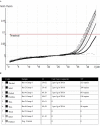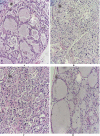Effects of bone marrow cell transplant on thyroid function in an I131-induced low T4 and elevated TSH rat model
- PMID: 17233913
- PMCID: PMC1784113
- DOI: 10.1186/1477-5751-6-1
Effects of bone marrow cell transplant on thyroid function in an I131-induced low T4 and elevated TSH rat model
Abstract
Background: We developed a study using low dose radioactive iodine creating an animal model of transient elevation of thyroid stimulating hormone (TSH). Male derived bone marrow cells were transplanted to asses their effect on thyroid function and their capability to repair the thyroid parenchyma.
Results: At 40 an 80 days after I131 treatment, the study groups TSH and T4 serum values both increased and decreased significantly respectively compared to the negative control group. Eight weeks after cell transplantation, neither TSH nor T4 showed a significant difference in any group. The mean number of SRY gene copies found in group I (Left Intracardiac Transplant) was 523.3 and those in group II (Intrathyroid Transplant) were only 73. Group III (No Transplant) and IV had no copies. Group I presented a partial restore of the histological pattern of rat thyroid with approximately 20%-30% of normal-sized follicles. Group II did not show any histological differences compared to group III (Positive control).
Conclusion: Both a significant increase of TSH and decrease of T4 can be induced as early as day 40 after a low dose of I131 in rats. Restore of normal thyroid function can be spontaneously achieved after using a low dose RAI in a rat model. The use of BM derived cells did not affect the re-establishment of thyroid function and might help restore the normal architecture after treatment with RAI.
Figures




Similar articles
-
Zinc sulphate following the administration of iodine-131 on the regulation of thyroid function, in rats.Hell J Nucl Med. 2007 Sep-Dec;10(3):167-71. Hell J Nucl Med. 2007. PMID: 18084658
-
NTP Toxicology and Carcinogenesis Studies of Salicylazosulfapyridine (CAS No. 599-79-1) in F344/N Rats and B6C3F1 Mice (Gavage Studies).Natl Toxicol Program Tech Rep Ser. 1997 May;457:1-327. Natl Toxicol Program Tech Rep Ser. 1997. PMID: 12587019
-
Alterations in rat brain thyroid hormone status following pre- and postnatal exposure to polychlorinated biphenyls (Aroclor 1254).Toxicol Appl Pharmacol. 1996 Feb;136(2):269-79. doi: 10.1006/taap.1996.0034. Toxicol Appl Pharmacol. 1996. PMID: 8619235
-
Etiology and outcome of non-estrogen associated hyperthyroxinemia in euthyroid patients at the San Juan City Hospital.Bol Asoc Med P R. 1996 Jan-Mar;88(1-3):12-5. Bol Asoc Med P R. 1996. PMID: 8885441
-
Evaluation of thyroid functions in leprosy. I. Thyroid function tests.Lepr India. 1977 Oct;49(4):485-91. Lepr India. 1977. PMID: 604656
References
-
- Körbling M, Anderlini P. Peripheral blood stem cell versus bone marrow allotransplantation: does the source of hematopoietic stem cells matter? Blood. 98:2900–2908. 15 November 2001. - PubMed
-
- Piano MR, Carrigan TM. Cellular cardiomyoplasty: a new therapeutic approach for regenerating the myocardium. J Cardiovasc Nurs. 2003;18:374–81. - PubMed
MeSH terms
Substances
LinkOut - more resources
Full Text Sources
Medical

